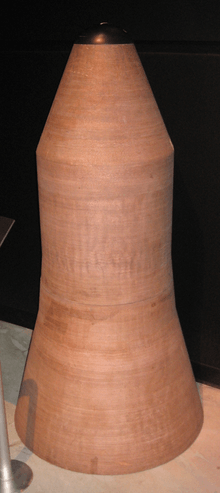W59
The W59 was an American thermonuclear warhead used on some Minuteman I ICBM missiles from 1962-1969, and planned to be used on the cancelled GAM-87 Skybolt air-launched ballistic missile. Modified to use a less-sensitive high explosive in the primary, the design formed the basis for the British WE.177, used by both the Royal Air Force and Royal Navy.

The W59 was 16.3 inches in diameter and 47.8 inches long, and it weighed 550 pounds (250 kg). It had a design yield of 1 megaton, with a yield-to-weight ratio of 4 kiloton per kilogram.
A total of 150 W59 warheads were produced during its lifetime.
The W59 was one of five nuclear weapon designs identified by researcher Chuck Hansen as using the common design Tsetse primary or first fission bomb stage. Hansen's research indicates that the Tsetse primary was used in the US B43 nuclear bomb, W44 nuclear warhead, W50 nuclear warhead, B57 nuclear bomb, and W59.
Historical evidence indicates that these weapons shared a reliability problem, which Hansen attributes to miscalculation of the reaction cross section of tritium in fusion reactions. The weapons were not tested as extensively as some prior models due to a mid-1960s nuclear test moratorium, and the reliability problem was discovered and fixed after the moratorium ended. This problem was apparently shared by the Python primary designs.
See also
- List of nuclear weapons
- Teller-Ulam design
- B43 nuclear bomb
- W44
- W50 (atomic weapon)
- B57 nuclear bomb
- ET.317
References
- Allbombs.html list of all US nuclear warheads at nuclearweaponarchive.org
- Beware the old story by Chuck Hansen, Bulletin of the Atomic Scientists, March/April 2001 pp. 52–55.